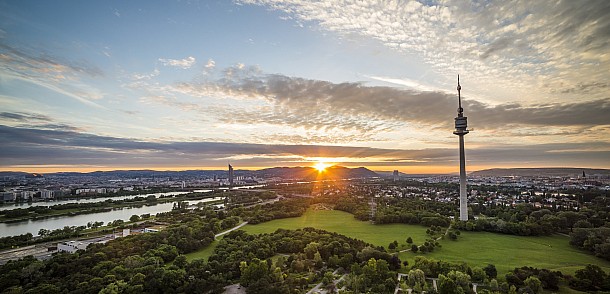Vienna, the capital of Austria, 2 million inhabitants, is situated on the banks of the Danube. The influx of visitors from all over the world has made Vienna the most popular urban tourist destination in Austria.
Vienna is a romantically imperial city: Vienna is a dream city for anyone with a romantic streak or an interest in history. Sightseeing opportunities are to be found in abundance. Wander along narrow, medieval alleyways or across imperial squares, view Schönbrunn Palace or the Imperial Palace (Hofburg) in the footsteps of Sissi and Emperor Franz Josef, and marvel at the majestic architecture along the Ring boulevard. Be inspired by an atmosphere steeped in history - which also boasts the comforts and infrastructure of a modern city!
Vienna is a city of Culture: Vienna possesses a lively and vast array of cultural attractions. Whether classical or experimental theatre, film or dance festivals, opera or operetta, or exhibitions and concerts - no matter when you come and how long you stay, there is sure to be something exciting for you to discover. Or if your tastes are not quite so culturally refined, then visit one of Vienna's famous coffee houses or traditional wine taverns ("Heurige") and work your way through famous culinary specialities. Wet your appetite!
Vienna is a city of Music: Vienna has been synonymous with music for centuries and was home to Mozart, Beethoven, Schubert and Johann Strauss. This outstanding musical heritage has been preserved right to the present day. The Wiener Philharmoniker is one of the world's top orchestras, the Vienna Boys' Choir is triumphantly successful wherever it tours, and the Vienna Conservatorium has produced innumerable international award-winners in all musical disciplines. Yet Vienna also boasts a lively scene for young people - if you love music, you are sure to profit from Vienna.
Vienna is a City of Art: Down the centuries, Vienna has always produced and nurtured world-famous artists. The collecting passion of art-loving rulers and monarchs has made Vienna a treasure house par excellence. The Museum of Fine Arts, for instance, is one of the world's largest and most distinguished museums, housing priceless works of art. Art accompanies you wherever you go in Vienna - even some of its underground stations are listed properties (on account of their elegant, ornamental Jugendstil style designed by Otto Wagner)! And Vienna is also uniquely zestful as far as its literature is concerned. After all, where else in the world will you find a city with its own "coffee house literature"?
Things to do in Vienna:
1. Salute the city’s favourite film:
Kicking off our list of things to do in Vienna is an endearing tribute to a classic film. The Third Man Private Collection houses one aficionado’s extensive collection of ‘Third Man’ marginalia and documentation on the aftermath of the war in Vienna. Posters, lobby cards and star portraits from around the world chronicle the movie’s marketing and its unforgettable rogues’ gallery of secondaries. You can see one of Anton Karas’ original zithers and hear the haunting theme tune; also on show are spin-offs such as board games, clocks and lighters. A new section offers a fascinating insight into life in post-World War II Vienna under the four-power occupation. Visitors also get to see an excerpt from the film on a 1936 German Ernemann VIIb 35mm projector, the model in use when post-war Viennese audiences shivered through the première in 1949.
2. Stroll through a musical park
The largest of the Ringstrasse parks, the Stadtpark stretches from just east of Schwarzenbergplatz to Stubentor, either side of the Wien river. Located beside Otto Wagner’s Stadtpark U-Bahn station, the main entrance is flanked by superb stone-carved Jugendstil colonnades. Just to the north is the park’s most emblematic building, the neo-Renaissance Kursalon, a venue for rather tacky Strauss concerts. Music is the theme here, and most visitors head for the schmaltzy but nonetheless finely executed gilt statue of Johann Strauss. Scattered around the park, you’ll also find busts of Schubert, Bruckner and Lehár (he of ‘The Merry Widow’.
3. Discover Viennese vino
The seven square kilometres of vineyards that lie within its boundaries make Vienna the world’s largest wine-growing capital city. The most extensive area is on the northern fringe in districts 16-19, but the highest quality vines lie over the Danube in the 21st district. On balmy summer evenings, join the Viennese for an evening in a Heuriger, one of the scores of rustic wine taverns dotted among the vineyards that skirt the Vienna Woods. The website www.heurigenkalender.at is a useful resource in English that provides up-to-date hours for venues in Vienna and beyond. The further you go, the higher the chances of finding the authenticity and breath-taking views that make a real Heuriger so memorable.
4. Hit the beach
The banks of the Danube, either side of the Neue Donau channel, are the nearest Vienna gets to a beach. Take the U1 to Donauinsel and walk until you find a suitable spot. Head downstream for the nude spots, which are marked FKK on maps. Two stops further on the U1, the Alte Donau has paying beach clubs such as the sprawling Gänsehäufel (601 12 8044), which has both swimming pools and beaches, and a peaceful nudist area; take the U1 to Kaisermühlen-Vienna International Centre, then bus 90a, 91a or 92a to Schüttauplatz. On the opposite bank, the best bet is the Bundesbad Alte Donau, a short walk from the U1 Alte Donau station.
5. Get an aerial view
No trip to Vienna is complete without a ride on the 19th-century Riesenrad or giant ferris wheel that features in ‘The Third Man’. It’s the only remaining work of British engineer Walter Basset who also built wheels for Blackpool, London and Paris. It was completed in 1897 to commemorate the Golden Jubilee of Franz Josef.
For More information visit the following Link:

0 comments: